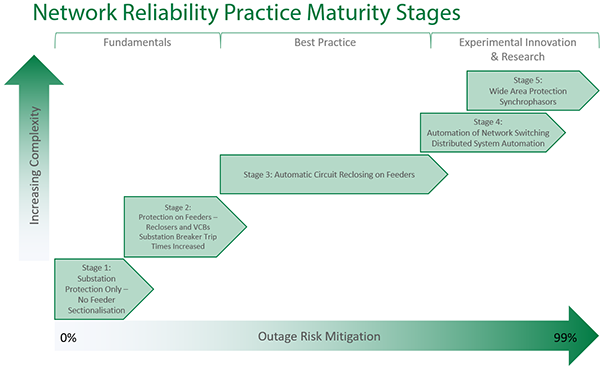#42 Marcela St., Damong Maliit, Brgy. Nagkaisang Nayon, Novaliches, Quezon City 1125, Metro Manila, Philippines

Grid scale distributed generation, rooftop solar and asynchronous sources make the answer to this challenge significantly more complex, but the fundamentals of reliability on overhead networks are still applicable.
With so many technologies claiming to offer reliability advantages, it is worthwhile to consider a staged progression. Going from substation level protection to a fully autonomous Smart Grid is a costly proposition. While it is possible to achieve, it’s difficult, and the added complexity in this configuration will probably reduce reliability, instead of improve it.
Based on NOJA Power’s field experience in supporting electricity reliability projects in 95 countries, a common theme of a staged approach to achieve Power system distribution reliability has appeared. This is shown in the figure below:

A core concept is that complexity is the enemy of reliability. Furthermore, successful projects in later stages of automation evolution rely on satisfactory achievement of earlier stages. It’s the electrical equivalent of walking before running.
Today, on overhead networks, if you configure substations to allow for a 1 second grading margin down radial feeders (Stage 2), and you implement appropriately graded, simple reclosing (Stage 3), the research says you will achieve an average 80% increase in reliability. This is based on the frequency of momentary faults, and the ability to safely deliver energy, within equipment constraints, to dislodge and clear faults.
The remaining 20% (rounded up), is confined firstly to “smart grid automation”, and finally the experimental research stages. While these are complex and show promise, trying to execute these without having grading properly configured (stage 3) is likely to reduce reliability, not enhance it.
Fortunately, the journey through these stages have been travelled by many before. Whilst NOJA Power actively works in the innovation protection space, such as the ARENA project for Synchrophasors on the MV grid, we have also built great reliability in distribution grids at the stage 3 level.
“Why are reclosers so popular for distribution grid reliability? The answer is simple 80% of faults can be cured by reclosing a distribution line,” reports NOJA Power Group Managing Director Neil O’Sullivan. “So without any need for communications infrastructure, SCADA systems, DMS systems or smart grid automation you can cure 80% of faults by installing a recloser and correctly grading it with the upstream protection. On unreliable feeders this is an instant improvement to the lives of all consumers on those feeders and why utilities continue to invest in reclosers for their overhead distribution networks.”
If you’d like to learn more, a full whitepaper on this network reliability model is available for your download.
Download White PaperOpens in new window
NOJA Power have supported medium voltage network operators around the world to achieve improvements in distribution reliability. If you have a switchgear project in mind, get in contact with NOJA Power at www.nojapower.com.au